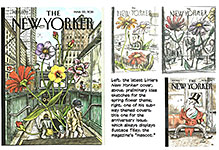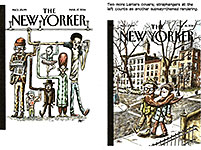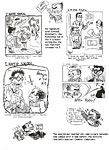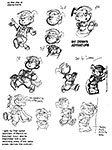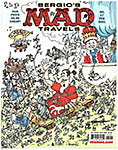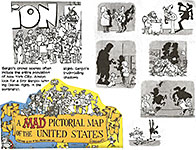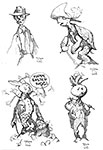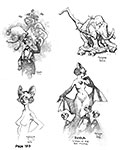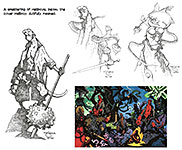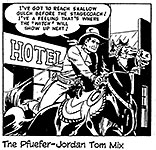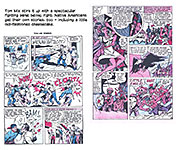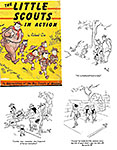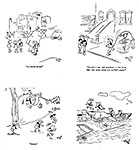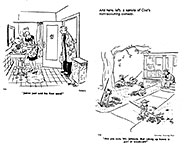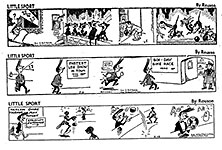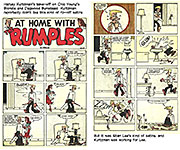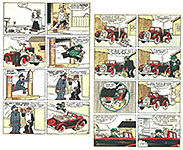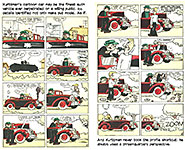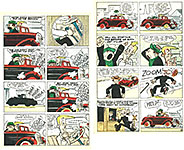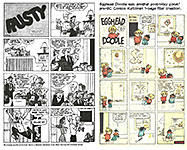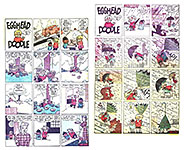 |
||||||||||||||||||||||||||||||||||||||||||||
Opus 416 (through April 5, 2021). Happy Easter.
By the time this reaches you, Easter will doubtless be a week in the past. But
I couldn’t stop myself from using Mike Mignola’s Easter Bunny as an
introductory illo for this opus. And I could not resist tacking on my own
rabbit, Cahoots, who, rather than applauding Mignola (as I do), voices
suspicion about the contents of any eggs emanating from the spooky and
harrowing halls of Mignoland. But if you want the Whole Story of Easter, bunnies and eggs and all, you should consult Harv’s Hindsight for May 2017, a really long, boring but thorough examination of historical matters. But herewith, our topics this time: Wonder Woman and H.G. Peter, 70th anniversary for both Dennises, Dagwood in an 8-pager, Liniers, the graphic brilliance of Hank Ketcham (and my Dennis adventure), and reviews of Mignola book, Golden Age Westerns, Brzrkr, plus historic Little Sport, and Harvey Kurtzman’s Rumples. Here’s what’s here, by department, in order (the longest entries are marked with an asterisk* a reader’s guide to help you decide where to spend your time)—:
NOUS R US Continuing Destruction of the Direct Market The Comeback Is Bigger than the Setback How Many Titles Is Enough? Wonder Woman Tells Her Age *And H.G. Peter Who Drew Her at First Dennis Is 70, Twice Top 10 Comicbooks Since 1970 Ginger Meggs Turns 100 This Year Mod Marvel Covers Jaffee Hits 100
FUNNYBOOK FAN FARE Brzrka
* BARENEKKIDWIMIN IN BLONDIE And a Little Copulation To Top It Off
TRUMPERIES The Antics and Idiocies of Our Bloviating Buffoon in Chief
* EDITOONERY The Mock in Democracy
YET ANOTHER POINT OF VIEW Marty Two Bulls
NEWSPAPER COMICS PAGE VIGIL The Bump and Grind of Daily Stripping Liniers Macanudo & Foreign Cartooners
LINIERS COVERS THE NEW YORKER
* DENNIS THE MENACE IS 70 Jim Engel and Dennis Marcus Hamilton Says My Adventure with Dennis The Graphic Brilliance of Hank Ketcham
BOOK MARQUEE Short Reviews The Love and Rockets Companion
BOOK REVIEWS Long Reviews, Critiques & Crotchets *Mike Mignola: The Quarantine Sketchbook *Golden Age Western Comics
BOTTOM LINERS Single Panel Magazine Cartooning Little Scouts
COLLECTORS’ CORNICHE Little Sport by John Henry Rousou Rumples by Harvey Kurtzman
PASSIN’ THROUGH Frank Thorne
* FORTY-FIVE LESSONS LIFE TAUGHT By Regina Brett, Age 90
QUOTE OF THE MONTH If Not of A Lifetime “Goddamn it, you’ve got to be kind.”—Kurt Vonnegut Our Motto: It takes all kinds. Live and let live. Wear glasses if you need ’em. But it’s hard to live by this axiom in the Age of Tea Baggers, so we’ve added another motto: Seven days without comics makes one weak. (You can’t have too many mottos.)
And in the same spirit, here’s—: Chatter matters, so let’s keep talking about comics. AND—
“If we can imagine a better world, then we can make a better world.”
And our customary reminder: don’t forget to activate the “Bathroom Button” by clicking on the “print friendly version” so you can print off a copy of just this installment for reading later, at your leisure while enthroned. Without further adieu, then, here we go—:
NOUS R US Some of All the News That Gives Us Fits
THE CONTINUING DESTRUCTION OF THE DIRECT MARKET The transformation of the Direct Market for comics, which began last year with DC’s move to a new distributor for comic stores, has just been thrown a new wrench with the announcement that Marvel has signed an exclusive multi-year agreement with Penguin Random House to distribute Marvel comics and graphic novels to comic stores. Hachette will remain (for now) Marvel’s distributor of graphic novels to the book trade. Under the new arrangement, PRHPS will sell to Diamond as a wholesaler, allowing Diamond to continue to offer Marvel products to its customers, albeit under different terms. PRHPS laid out some its plans for serving the Direct Market, including free freight to retailers on Marvel products, as it does on its other lines. Marvel Entertainment President Dan Buckley said: “Comics are the core of the Marvel Universe, and we are confident this new partnership will continue to grow and evolve this resilient industry. We look forward to advancing our capabilities with PRHPS to serve our fans and the Direct Market. We thank Diamond for their many years of support and partnership as we continue our relationship with them in other areas.” Diamond Comic Distributors CEO Steve Geppi (statement released separately): “We value our almost 40-year relationship with Marvel and are pleased that we will continue selling Marvel products to the Direct Market and other channels. The change Marvel announced today represents a behind-the-scenes shift in how Diamond interacts with Marvel for certain products .... I expect the discount terms under which our retail partners order these Marvel products to change. ... While there are still details of this new arrangement to work through, my leadership team and I are committed to making this supply change as operationally seamless as possible for our retail partners and we look forward to our continued distribution of Marvel products.” Others expressed other concerns. One retailer said: “All comic publishers that aren’t DC or Marvel—now’s probably a great time to see of you can renegotiate your contracts with Diamond.” Another asked: “Does this mean your local comic store now will have to compete with chain bookstores? Will Marvel focus their content for longer shelf-life? If this sinks Diamond or—more likely—forces cutbacks, what happens to small publishers? ... Geppi is more likely to close up shop entirely than try to make money on those thin margins. Heidi MacDonald said: “While some retailers may feel more comfortable going with Diamond for periodicals, it’s hard to see many advantages in using Diamond for graphic novels. PRH already distributes DC, Archie, IDW, Dark Horse, and Kodansha Comics to all markets, so a lot of comics shops already have a relationship with them.
THE COMEBACK IS BIGGER THAN THE SETBACK Marking off a year of Pandemic Life, Heidi MacDonald at comicsbeat.com remembered that it was March 23rd in 2020 that Diamond president Steve Geppi announced they would cease shipping new comics starting April 1st, effectively putting the comics industry on hold. Shops nearly everywhere shut down for almost two months. Within a few days, DC dropped it’s own bombshell announcing that it would be moving to new distributors. There was no dearth of coverage and fretting about this, as, with people stuck at home, there was little else to do. You can find the Beat’s own coverage on the crisis in various places and see how good we did at predicting things: One year later, comics and comics retailers have survived the “Pandemic Shift” in good shape, but we thought it was time to reach out to retailers to look back at that scary period and talk about the ways they’ve adapted and the lessons they’ve learned. ... In my cover letter asking for thoughts, I noted that Diamond’s Geppi had predicted “the comeback will be bigger than the setback” and he’s proven to be correct, as comics sales were robust in the second half of 2020 – even bigger than 2021 in some cases. However, reading the responses, we see that we’re not out of the woods yet – retailers worry that as other forms of entertainment like live events and theater going return, comics will face more competition and the sales boom could evaporate. It’s a relevant concern, but it also marks the surprising strength of the comics industry: the pandemic has seen comics go from a shut down of new weekly comics delivery to one of the most reliable forms of COVID-era entertainment. ... For stores that rely solely on the new releases, this was “the most traumatic” but for stores who have in-stock books and comics, the lack of new releases led to sales of their backstock. If comics didn’t entirely “shut down,” March 23rd was still a day that marked a seismic shift – and the realization that everything we thought was true could change. But as the responses we got show, the comics industry is strong, nimble and dedicated. ... With this kind of perseverance and (yes) passion for the medium, we can overcome just about anything.
HOW MANY TITLES IS ENOUGH Paul Levitz, who entered comics as a writer and retired as Publisher of DC Comics, is back writing, saith ICv2—but prose, apparently, not stories. Herewith, he examines what the pandemic taught us about the question of how many comic titles is enough—: One of the few pleasant surprises of this virus-plagued year is how resilient the comic shops have proved to be. Even those of us who are longtime supporters of the system feared that we would lose large numbers of shops, and with them, large numbers of readers who would find comics shopping just too damn inconvenient in a time filled with too many challenges. Happily, that didn’t prove to be the case. A number of shops went under, to be sure, which is bad news for the owners, staffers and patrons of those stores, but we’ve seen a fair number of new outlets open up too, and the net loss has been much lower than we “experts” predicted. Consider that testimony to the dedication of the people who own and run the stores, the surprisingly effective program of PPP funding provided by the federal government, and the degree of passion our readers have for getting the comics they needed as entertainment in a particularly bleak period. A second thread of good news has been increased sales of many titles that have been published since most stores were allowed to reopen on some basis by their states. ... Some of this phenomenon can be attributed to the extra leisure time we’re all experiencing as captives of our homes, without access to as many other activities as usual. Another factor is certainly a run of better content in some major publishers’ titles, which often has had the effect of also lifting smaller publishers’ sales by bringing more customers to the cash registers and making them more enthusiastic about our shared hobby. But some retailers are also attributing the increase to the decrease in the number of titles being published, both by removing clutter in their displays, and concentrating readers’ attention on the better books. ... Levitz concludes his essay by cautioning against publishers’ "overproduction," and particularly the proliferation of titles featuring the top characters in any line. Back in the day, even as I signed off on adding to the Superman or Batman line, I was reluctant to go over the "one new issue a week" rule, assuming that since our readers mostly shopped weekly, that was a safe limit. ... Perhaps the comparative success of more titles during this period of shortened schedules shows that a more careful curation strategy can work. Stores should be open to try new series and graphic novels, and should make sure they have a system where consumers can get anything comics-related they desire as easily as ordering it online. But the display racks seem to be benefiting from more focus, and that’s within retailers’ ability to continue. Let’s keep these improbable good times going!
WONDER WOMAN TELLS HER AGE A DC publicity release announced that DC, Warner Bros, Global Brands and Experiences and WarnerMedia are bringing the “Wonder” to International Women’s Day by launching a global celebration that honors the 80-year legacy of DC’s Champion of Truth and Warrior for Peace— Wonder Woman. Embracing the call to see the world through Wonder Woman’s eyes and to “Believe in Wonder,” the 80th Anniversary celebration illuminates the Super Hero’s timeless and relevant message of hope and empowerment with original content, commemorative comics, books, and global fashion collections and experiences. This multi-month campaign will culminate with a worldwide celebration of Wonder Woman Day on October 21. The legacy of Wonder Woman includes the first appearance of Wonder Woman in All-Star Comics No.8, the first comicbook headlined by Wonder Woman (Sensation Comics No.1), and the publication of Wonder Woman No.1 in 1942. All are free to read on the ultimate fan destination for DC: DC UNIVERSE INFINITE. DC also announced the Wonder Woman 80th Anniversary 100-Page Spectacular that will bring together some of the greatest storytellers in comics and entertainment for a tribute to Wonder Woman in a collectible keepsake. Available in October on Wonder Woman Day, fans can look forward to original stories and a beautiful art montage by Eisner Award-winning artist Yanick Paquette (Wonder Woman: Earth One) with colors by Nathan Fairbairn.
The History of Wonder Woman. Created by William Moulton Marston, a psychologist who was a pioneer in lie-detection by electronic means, Wonder Woman was conceived as a new type of super hero who used wisdom and compassion, not just her fists, to triumph over evil. Born and raised on Themyscira, Diana is the immortal daughter of the Amazonian Queen Hippolyta. After training to be the ultimate warrior, she chooses to leave her paradise island home and join the world of mortals, where she becomes a champion for justice and equality as Wonder Woman. She was imbued by the gods with powers including super-strength and gifted with a lasso that compels anyone bound by it to tell the truth. Wonder Woman is the only female comic book character to have her own stories continuously published for the past three-plus quarters of a century. Wonder Woman first appeared in All Star Comics No.8 on October 21,1941 in a back-up story meant to test her appeal at a time when female super heroes were rare. An instant favorite, Wonder Woman was soon headlining her own standalone title less than a year later. Subsequent generations came to know the Amazonian princess with silver bracelets on her wrists and a magic lasso by her waist via her hit 1970’s television series as well as roles in animated shows and movies. The groundbreaking 2017 film “Wonder Woman” by director Patty Jenkins and starring Gal Gadot was the largest grossing live action film ever for a female director at the time of release. The sequel, “Wonder Woman 1984" premiered on HBOMax and in theaters globally December 25, 2020. Warner Bros. Pictures confirmed the third Wonder Woman movie starring Gadot will also be written by Jenkins. Fans can join in on social media using hashtags #WonderWoman80 and #BelieveInWonder. Visit wonderwoman80.com for the latest news and updates.
SPEAKING OF WONDERS, the most wonderful part of Wonder Woman’s history is H.G. (Henry George) Peter, the artist who drew her comicbook adventures from the beginning in 1941 until his death in 1958 at the age of 78. Peter had been making a living doing illustrations and cartoons for newspapers and magazines, including the humor magazine Judge. As you can see from the accompanying visual aids, he drew in the elaborate illustrative manner of Charles Dana Gibson and others of the period, roughly 1890-1920—a manner that he dropped entirely when drawing Wonder Woman.
Why he so suddenly developed a different much simpler style of drawing is something of a mystery. My guess is that someone told him that pictures rendered for the addition of color (as in comicbooks) needed to be simpler. They certainly should not be drawn in Peter’s elaborately shaded and hachured manner of the nineteenth century. Laying color over such complex linework would simply turn the picture into mud. St. Wikipedia says Peter’s new simpler manner was a version of Art Nouveau style, but there are those, Rob Stolzer at his Inkslinger blog f’instance, who disagree. “There was a goofy expressionism to Peter’s later work, with a heavily brushed contour line and figures that moved with little grace, yet conveyed a sense of power. Hardly the stuff of Art Nouveau, which was largely curvilinear and organic.” Goofy expressionism, okay. Another
mystery about Peter is how he got the Wonder Woman gig to begin with. Nothing
in his previous work suggested he could do a costumed superheroine. But
somehow, he attracted the attention of William Moulton Marston, who had come up
with the idea of a super woman character to glorify womanhood for moral
leadership of the world. The strong woman idea was Marston’s; but the
appearance of the character was Peter’s, as we can see in the scan of the
conceptual moment posted near here. Peter’s note on his Wonder Woman drawing is as follows (in italics)—: Dear Dr. Marston, I slapped these two out in a hurry. The eagle is tough to handle — when in perspective or in profile, he doesn’t show up clearly — the shoes look like a stenographer’s. I think the idea might be incorporated as a sort of Roman contraption. Peter Marston’s response (in italics): Dear Pete — I think the gal with hand up is very cute. I like her skirt, legs, hair. Bracelets okay + boots. These probably will work out. See other suggestions enclosed. No on these + stripes — red + white. With eagle’s wings above or below breasts as per enclosed? Leave it to you. Don’t we have to put a red stripe around her waist as belt? I thought Gaines wanted it — don’t remember. Circlet will have to go higher — more like crown — see suggestions enclosed. See you Wednesday morning - WMM. The tone of Marston’s note is friendly. He seems to be writing to someone he’s known for a while. Had they worked together before? Peter addressed Marston as “Dr.,” a sign of respect for Marston’s title and professional status, but otherwise more-or-less friendly. According to St. Wikipedia, by the late 1930s, Peter had been dabbling in comic book illustration, doing work for Lloyd Jacquet's comic shop, Funnies, Inc., and a few panels for George Hecht’s True Comics. By the time Marston happened upon him, Peter was in his sixties. So how did Marston run into this guy? And why pick an artist whose drawing style was so conspicuously wrong for four-color comics? The common thread binding the two is women’s suffrage. Marston’s allegiance to feminism has long been established. Peter, born in California, was a staff artist at the San Francisco Chronicle during the years when its pages closely covered the suffrage movement in the state, says Jill Lepore in her masterful The Secret History of Wonder Woman (Knopf 2014). The woman Peter eventually married, Adonica Fulton, was another newspaper artist “and, very probably, a suffragist.” The two moved to New York by 1908, and Peter was making pen-and-ink illustrations/cartoons for Judge. At Judge, Peter met the feminist cartoonist Lou Rogers. “Between 1912 and 1917,” says Lepore, “both Peter and Rogers contributed illustrations to Judge’s regular pro-suffrage feature, ‘The Modern Woman.’” And it was doubtless in that feature that Marston saw Peter. That Peter’s drawing style at the time bore no hint of comicbook illustration is immaterial: Marston was more politician than art critic, and he wanted Wonder Woman to be drawn by a sympathetic hand. He said he liked that Peter knew “what life is all about”—i.e., about women’s right to vote. Max Gaines, DC publisher, and Marston knew what they wanted in Wonder Woman. “She had to be strong, and she had to be independent. ... [And she] had to be uncommonly beautiful. ... Like [the recently launched] Captain America, Wonder Woman would have to wear red, white, and blue. But, ideally, she’d also wear very little. To sell magazines, Gaines wanted his superwoman to be as naked as he could get away with.” Marston also suggested that Wonder Woman should look like a Varga girl, the popular pin-up feature in Esquire magazine —“long-legged, slender, and open-mouthed,” as Lepore put it. “She wore her hair down, her nails polished, her legs bare, and barely any more clothing than what a swimsuit covers. ... Wonder Woman looked as though she could have been on a page of Esquire’s annual pin-up calendar. ... Wonder Woman, as Peter eventually drew her, looks very unlike any of his earlier drawings of women. She’s less a Gibson girl than a Varga Girl, with a great deal of Lou Rogers added in: the suffragist as pin-up.”
Commemorative Wonder Books. Wonderful Women of History – Available September 28, 2021, this young adult graphic novel continues DC’s rich legacy of celebrating inspirational figures throughout history and hearkens back to the original “Wonder Woman of History” feature series that ran in the back of issues of Sensation Comics and Wonder Woman from 1942-1954. Presented in a graphic novel style, the anthology profiles women from all walks of life who are inspiring young readers today to be the leaders of tomorrow who learn, build and dream. Sensational Wonder Woman Vol. 1 – Available in comic book stores, book retailers and on digital platforms on October 5, this book collects the first six issues of an anthology of self-contained Wonder Woman stories from some of the industry’s most popular writers and artists. Wonder Woman Earth One Vol. 3 – Available at comic book stores, book stores and on participating digital platforms, this volume is the epic conclusion to the New York Times bestselling original graphic novel series from the acclaimed team of writer Grant Morrison and artist Yanick Paquette.
DENNIS IS 70, TWICE Seventy years ago, on March 12, 1951, Hank Ketcham’s Dennis the Menace debuted in American newspapers. A week later, on March 17, another Dennis the Menace strolled on to the pages of The Beano, a weekly comic magazine in Britain (since 1938; it published its 4,000th issue on August 28, 2019). The British Dennis is somewhat older than the American Dennis, and he isn’t just an accidentally misbehaving kid: the British Dennis is a scheming prankster, who deliberately seeks to do mischief. Other comic characters in The Beano include Minnie the Minx, The Bash Street Kids, The Numskulls, Roger the Dodger, Billy Whizz and Tricky Dicky. Earlier characters who have been phased out include Ball Boy, Les Pretend, Ivy the Terrible, The Three Bears and Pansy Potter. Some old characters, like Biffo the Bear, Lord Snooty, Baby Face Finlayson and Little Plum, have more recently made a return as "funsize" quarter-page strips. The style of Beano humor has shifted noticeably over the years, though the longstanding tradition of anarchic humor has remained. Historically, many protagonists were characterized by their immoral behaviour, e.g. pranking (Dennis the Menace), dishonesty (Roger the Dodger) and even robbery (Baby Face Finlayson and The Three Bears). Although the readers' sympathies are assumed to be with the miscreants, the latter are very often shown punished for their actions. Recent years have seen a rise in humor involving gross bodily functions, especially flatulence (which would have been taboo in children's comics prior to the 1990s), while depictions of corporal punishment have declined. For example, the literal slipper – the footgear that is the most common form of chastisement for characters such as Dennis, Minnie the Minx and Roger the Dodger – has become the name of the local chief of police (Sergeant Slipper). Dennis the Menace, the first naughty kid character for The Beano, was dreamed up when the weekly’s editor, George Moonie, heard a music hall song called “I’m Dennis the Menace from Venice.” “Dennis came along after the austerity of the 1940s, after this belief that kids should be seen and not heard, and then all of a sudden you have this character through whom kids can live vicariously,” said Mike Stirling, editorial director of Beano Studios. “He started off as a half-page strip on page five, but he was so successful that by the end of the 1950s you had Minnie the Minx, the Bash Street Kids and Roger the Dodger as well, because the naughtiness was such a success. The kids aren’t fighting against each other, they’re fighting against the grownups. Kids were not just being seen, but being heard.” Dennis was drawn by David Law until 1970, when David Sutherland took over. Then in 1998, another David, Parkins, inherited the job. In 2004, Nigel Parkinson, Jimmy Hansen and Tom Paterson teamed up to produce the strip, through the relaunch in 2009-2010. Barrie Appleby did it for the next two years, and then Nigel Parkinson returned with Nigel Auchterlounie, and they continue today. When the strip was relaunched in 2009, Dennis faced several changes to his character and appearance, saith St. Wikipedia. It was the first major revamp of the character since his debut over 50 years prior. Parkinson, Hansen and Paterson continued to draw the strips, although Dennis became slightly shorter with a boyish look to him as opposed to the brute, tough guy look the previous artists had established. His behind the nose grin was used far less frequently and most of his menacing was toned down. He also no longer used weapons such as a catapult or peashooter save for a few times, so he became more creative in his mischief. The reason behind the re-launch was to promote the new TV series which was just about to hit screens in Britain. It followed Dennis and his cohorts as they attempt to brighten up the average day in Beanotown through new ideas, adventures and pranks. Beano Studios is marking Dennis’s anniversary with a special birthday edition of the comic. By
1974, Dennis had replaced Biffo the Bear as Beano’s cover star, and –
although he remains forever 10 years old (Ketcham’s Dennis is forever
five-ana-half) – he is now the comic’s longest-running strip. The character’s
appearance has changed over the years; his shirt and tie were replaced by his
red and black jumper by April 1951, the colors chosen because those were the
two strongest colors of ink available to printers in the 1950s. Dennis has grown and shrunk in size over the years, and his mouth has moved from behind his nose to further down his face, but one of the greatest changes in the strip has been the evolution of his nemesis and neighbor Walter. Portrayed in the past as weak and effeminate, today Walter is “more than Dennis’s equal,” said Stirling. “It looked like Dennis was bullying Walter, and bullying is a big problem, so we didn’t want to do anything that would ever suggest it’s something we’d want in Beanotown,” said Stirling. “So we made Walter physically Dennis’s equal, and sometimes he gets the upper hand.” The Beano team consults a group of children from across the country, speaking to them each week about “what’s happening in the playground, what they’re watching on TV, what games they’re playing, and these help us inform the character,” says Stirling. “It makes sure our character is evolving, that Dennis is reflecting the life of a 10-year-old kid in the here and now.” The surname of the British Dennis, The Beano confirms, is Menace. Ketcham’s kid is Dennis Mitchell. We celebrate the 70th anniversary of Ketcham’s Dennis way down the scroll under the heading DENNIS THEMENACE IS 70. Don’t forget to join the party.
TOP 10 COMICBOOKS SINCE 1970 The Overstreet Comic Book Price Guide No.50 listed the Top 10 comics published since 1970, the year the Guide debuted. Here they are—: Star Wars No.1, $12,000; starts adaptation of the first movie Teenage Mutant Ninja Turtles No.1, $8,000; first appearance and origin of the Turtles Gobbledygook No.1, $6,600; TMN Turtles appear on back cover Incredible Hulk No.181, $5,500; first full Wolverine story Iron Fist No.14, $4,400; first appearance of Sabretooth House of Secrets No.92, $3,350; first appearance of Swamp Thing Cerebus the Aardvark No.1, $3,200; debut of Cerebus Albedo No.2, $3,200; first appearance of Usagi Yojimbo Scooby Doo No.1, $3,000; first comic book appearance Marvel Spotlight No.5, $2,800; first appearance of Ghost Rider
I’m surprised by the standing of Teenage Mutant Ninja Turtles. Ditto Cerebus. I realize that TMNT was big as a comicbook phenomenon, but for one issue to sell so much surprises me. Cerebus, for those of you who followed his adventures back in the day, has deteriorated alarmingly. Dave Sim no longer actually draws it. Something wrong with his drawing hand. Or his eyesight. Can’t remember which. Anyway, as you can see from the display near here, the Cerebus comicbook/magazine consists now of endless repetition. The page you see here is repeated several times in the magazine with different speech balloons each time. That’s it, kimo sabe. So all that’s left of Cerebus is Sim’s somewhat disjointed sense of humor.
GINGER MEGGS TURNS 100 THIS YEAR Ginger Meggs, about the eponymous red-headed larrikin kid who never gets old, is Australia’s longest-running comic strip. Turning 100 this year, it’s the third longest-running comic strip in the world—after The Katzenjammer Kids (which began December 12, 1897) and Gasoline Alley (November 24, 1918). Often called Australia’s most loved comic character, “Ginge,” as the character is affectionately known, was created in approximately 1921 by Jim Bancks in a strip entitled Us Fellers. Ginge was, at first, just a bit player, but as the irrepressible schoolboy, he soon assumed the lead role in the strip, which, in 1939, surrendered to the inevitable and become Ginger Meggs.
In John Ryan’s history of Australian comics, Panel by Panel, Ryan writes about Bancks and Ginge: “Drawing on his own boyhood, Bancks was able to capture all the character, warmth and charm of a typical Australian boy. Ginge’s homespun philosophy and observations on life were a delight and represented an aspect of the strip that was never duplicated by his many imitators. For Ginge, life was meant for playing sport, going to the movies, attending birthday parties or picnics, and for gobbling down ice cream, cakes and fruit. He viewed school homework and helping around the house as diabolical plots intended to deprive him of the real pleasures of living.” In Australia, comic strips are associated with newspaper rather than with syndicates, and when Bancks moved his strip to another paper, 80,000 readers followed him. And the paper he left went into bankruptcy. Ginger is published in 34 countries, including a few U.S. newspapers, and he is written and drawn by Jason Chatfield, 37, an Aussie who moved to the U.S. several years ago and is now president of the National Cartoonists Society. He also served a term as president of the Australian Cartoonists’ Association (2010-2012). Chatfield is a standup comedian whenever he can break away from the drawingboard. Chatfield is the fifth cartoonist to bring Ginger Meggs to life. His immediate predecessor was James Kemsley, who turned the strip over to Chatfield in 2007 after consulting with the Bancks family. Kemsley used to joke about his term on the strip. Bancks died after 30 years on the strip; Ron Vivian, after 20 years; Lloyd Piper, after 10. Noting the steady progression downwards in these terms, Kemsley quipped: “So when I was offered the job in 1984, they gave me a 5-year contract.” He actually complete 23 years, dying in December 2007. He worked harder than any of his predecessors on the strip: he inaugurated the daily Ginger Meggs in 1993. Kemsley also started the tradition of lettering some wise or ridiculous saying into one of the strip’s panels every day. It began quite innocently: once, Kemsley was out-of-town and would miss the practice session of his cricket team (or some such), so he lettered this “news” in code into the strip for that day, expecting his team-mates to see it and act accordingly. Thereafter, readers expected (and demanded) these “extras.” And Kemsley complied. A book celebrating the anniversary is to be published in May.
MOD MARVEL COVERS Publisher
Description. This
May, fans will be presented with a bold new vision of the Marvel Universe in
Heroes Reborn. Crafted by writer Jason Aaron and artist Ed McGuiness,
this series will present a world without the Avengers where the Squadron
Supreme had to rise up to take their place. To celebrate this grand
venture into a new age, Marvel is proud to debut a new series of variant covers
by renowned artist and writer Jeffrey Veregge. This extraordinary collection
will grace the covers of each issue of Heroes Reborn, giving readers a unique
view of the new Marvel Universe with depictions of Hyperion, Blur, Doctor
Spectrum, and more in Veregge’s iconic Formline style.
JAFFEE HITS 100 Al Jaffee, one of the last of Mad’s original “Usual Gang of Idiots,” celebrated his 100th birthday on March 13. “Hitting the century mark in age, it’s a nice number” for the brain to consider, Jaffee said with a warm laugh from his New York home, where Michael Cavna contacted him by phone — even if some body parts don’t “seem to appreciate it.” To mark the occasion, the humor magazine announced that its “Mad Predicts the Future” edition, on sale in April, will salute its eldest statesman. Cavna reports that the issue’s center-spread article, titled, “Amazing All-Seeing Al Jaffee’s MAD E.S.P.,” will note how the artist’s ever-inventive mind foresaw such ideas as the multi-bladed razor and the “autocorrect” function — once described and drawn in the artist’s wry style. Jaffee, who made his Mad debut 65 years ago, is best-known for the magazine’s iconic back-page Fold-In — he has created more than 450 of them — and the running feature “Snappy Answers to Stupid Questions.” The Washington Post once posed its stupidest question to Jaffee: “Are you proud that your work with Mad endures?” Snapped Jaffee: “I would be stupid to say, ‘No.’” Jaffee began his scareer in 1942, with Joker Comics, and has worked continuously until last year, when he officially retired. In 2016, Guinness World Records awarded him its title of “longest career as a comic artist.” Since he was never on the staff of Mad, he probably holds the supplemental title of “longest-working freelancer.” He has collected several professional honors, including the National Cartoonists Society’s Reuben Award and the Will Eisner Hall of Fame. Five years ago, New York Mayor Bill de Blasio declared March 30 Al Jaffee Day. “The most impressive thing about Al and his work is his seemingly bottomless well of great ideas for features, and how varied they are,” says caricaturist Tom Richmond, who rendered the new center-spread piece. “If all he did was invent the Fold-In and write and draw it for 55 years, that would already be deserving of legend status. But he did so much more: comic books, comic strips and features for Mad that were completely different from one to the next.”
Fascinating Footnit. Much of the news retailed in the foregoing segment is culled from articles indexed at https://www.facebook.com/comicsresearchbibliography/, and eventually compiled into the Comics Research Bibliography, by Michael Rhode, who covers comic books, comic strips, animation, caricature, cartoons, bandes dessinees and related topics. It also provides links to numerous other sites that delve deeply into cartooning topics. For even more comics news, consult these three other sites: Mark Evanier’s povonline.com, Alan Gardner’s DailyCartoonist.com (now operated without Gardner by AndrewsMcMeel, D.D. Degg, editor); and Michael Cavna at voices.washingtonpost.com./comic-riffs . For delving into the history of our beloved medium, you can’t go wrong by visiting Allan Holtz’s strippersguide.blogspot.com, where Allan regularly posts rare findings from his forays into the vast reaches of newspaper microfilm files hither and yon.
FURTHER ADO Comics are pictorial narratives or expositions in which the pictures blend with words to achieve a meaning that neither conveys alone without the other.
FUNNYBOOK FAN FARE Four-color Frolics An admirable first issue must, above all else, contain such matter as will compel a reader to buy the second issue. At the same time, while provoking curiosity through mysteriousness, a good first issue must avoid being so mysterious as to be cryptic or incomprehensible. And, thirdly, it should introduce the title’s principals, preferably in a way that makes us care about them. Fourth, a first issue should include a complete “episode”—that is, something should happen, a crisis of some kind, which is resolved by the end of the issue, without, at the same time, detracting from the cliffhanger aspect of the effort that will compel us to buy the next issue. A completed episode displays decisive action or attitude, telling us that the book’s creators can manage their medium.
OVER HALF of Keanu Reeves and Matt Kindt’s Brzrkr No.1 is bloodshed and brutality—23 of the book’s 43 pages. The two pages that open the book show our hero sitting, wordlessly, captionless, on a bench in the rain. After that, the action starts—the bloodiest action sequences I’ve seen in a comicbook in a long time. Maybe forever. Our so-far nameless hero is part of a military operation in which he jumps from an airplane and lands amid the enemy. Then he attacks, assaulting them, one by one, savagely, with pistol and fists, mostly fists. And when he hits someone, it’s usually in the face, and the force of his blow disintegrates the face. Ditto the stomach if he hits the stomach.
But the enemy is not standing idle. They pour bullets into him. But nothing stops him. He bleeds but keeps on. At the end of the “mission,” he’s taken to a medical facility where his body is restored to some semblance of health. One of the physicians confesses to him that she is puzzled by what she saw on the monitoring device—something different going on in his brain. On the last pages in the book, we are transported to some early society 80,000 years ago on the occasion of our hero’s birth. His voice-over remarks: “I remember being born.” The end of this issue. Ron Garney’s vigorous drawings of the vicious action are crisp and chipped with black, enough to keep my attention even without my knowing what it’s all about—although one suspects, once it registers that the guy is being regularly shot, that some kind of strange science is involved, and our desire to know more about that keeps us going. Whatever Reeves/Kindt’s instructions to Garney may be, Garney is able to translate them into vibrant life, keeping our interest high even though the action is highly repetitive—fisticuffs and firepower. The book sold amazingly well. Orders came in at 616,841, a source close to the project told Milton Griepp at ICv2. These are the second highest announced orders of the century, trailing only Marvel’s Star Wars No.1, which had advance orders from Diamond North America (the Brzrkr orders are worldwide orders) for 985,976 in 2015. “They are likely the largest orders for a title not published by Marvel or DC since the early 90s, just as Image was launching,” said Griepp. Orders were all through the direct market comic stores serviced by Diamond Comic Distributors. And the project comes to trade with major momentum: the Kickstarter for the graphic novel collections raised over $1.4 million, another record, the top comic project on Kickstarter for 2020. That’s not all the good news. Netflix has acquired media rights for Brzrkr, and creator and co-writer Reeves is attached. The plan is to produce a feature film starring Reeves, followed by an anime series with Reeves voicing his character.
QUOTES & MOTS “I’ll take any credit that isn’t nailed down.”—Stan Lee
BARENEKKIDWIMIN IN BLONDIE And a Little Copulation To Top It Off HERE'S
SOMETHING you don't see everyday— a topless babe in Blondie. Even though
this picture never appeared in the syndicated strip, it stars the Blondie cast. Blondie was being drawn by Stan Drake in 1991, the year of this
picture, also drawn by Drake. Drake had drawn The Heart of Juliet Jones prior to doing Blondie— a superb job of realistic illustration. So
he knew how to draw the curvaceous gender, heart, soul and buzzoom. I don't
know what this picture was for. Probably something with the National
Cartoonists Society, the Reuben program booklet maybe. In
the scenario at hand, Blondie is the righteous self-respecting (always)
mother/wife figure, but when the strip began September 8, 1930, she was a
fun-loving flapper. She never appeared topless, but if she had, it wouldn’t
have been out of character then as evident from a couple early Blondie strips
we’ve posted nearby. Whilst casting about for something altogether different, I encountered the single Dagwood panel seen here beneath the early Blondies That’s not a naked Blondie in the picture, but it is a naked babe, who comes from one of those pornographic 8-page “bibles” that once (alas, no longer) infested backrooms of bookstores and under-the-counters of magazine stands all across the nation. The typical 8-pager presented one panel per page (for eight pages, hence the name) featuring a sexual adventure of a celebrity or, more likely, a comic strip character. Near here, we’ve posted an assortment of panels to give you the idea of the usual quality of the work, only vaguely proximate the original and usually the crudest possible imitation as we see in these examples.
The solitary Dagwood panel soon led me to the entire 8-pager relating his adventure that day at the office. The whole enterprise is an unusually well-drawn specimen as you can readily tell from its 8 pages that I’ve posted at the elbow of your eye. Apart from the excellence of the imitation Dagwood and his boss, Mister Dithers, the cavorting babes look like they were drawn by Don Flowers, one of the champion limners of the babe gender in the 1930s and 1940s.
QUOTES & MOTS A philosopher once, named Descartes, Was explaining himself to a tart. “Since I think —I exist,” He remarked as he pissed, “But what does it mean when I fart?”
TRUMPERIES The Antics and Idiocies of Our Bloviating Buffoon in Chief NOT UNEXPECTEDLY, we’re shutting this department down, slaming its door on the butt of the departing Trumpet. We’ve never had it so good as when he was around to ridicule. My guess is that he won’t be back for another run in 2024. He keeps hinting that he might run again then, but that’s all hogwash intended to help fill the Trumpet coffers. As long as he keeps up the pretense of being a serious presidential candidate, he can go on collecting millions in donations from his enthralled admirers. And since there’s no restriction on how he should spend that money, he counts it as ordinary income, like a paycheck (for providing political entertainment). By way of farewell, here are a couple likenesses of the Trumpet that I enjoyed—one of mine, too.
EDITOONERY The Mock in Democracy GUNS WERE BACK IN THE HEADLINES this month. Guns and mass murder. Gun rights people keep saying, “Guns don’t kill people; people kill people,” strenuously implying that regulating guns won’t solve our problem. But the U.S. has one of the highest death rates from guns in the world; it also has the greatest number of guns—120.5 per 100 inhabitants. If that correlation doesn’t make a connection worth acting on, what does? Nothing, saith the gun righteous. Our
first visual aid offers some views on gun violence. Michael Ramirez’s image
shrouds Uncle Sam in funereal solid black, only his hands and coat cuffs
showing, the stars proclaiming his identity. “No” he says, softly. Not again,
he might’ve said. Next around the clock, Nick Anderson offers a bitter angry comment. Gun violence is our normal? Then Mike Peters shifts our attention to the purely mercenary. The gun industry is huge, requiring annual sales in the millions of millions. Peters turns the National Rambo Association’s apparent motto into a “buy word” so we’ll let bygones be bygones. Gun sales soar after every mass shooting. Moreover, it’s no coincidence that Peters’ characterization of NRA is the familiar Grandstanding Obstructionist Pachyderm of the Republicon Party. Rick McKee’s metaphor is the familiar pie-chart, to which he has attached caricatures of the opposing sides in the national debate. But Uncle Sam occupies the statistical center. McKee notes: “By a huge majority, most Americans support common sense measures to keep guns out of the hands of the mentally ill to reduce mass shootings.” But that, alas, would not be enough. Mentally ill people aren’t the cause of mass murder. In my view, mass murders are committed to demonstrate the shooter’s power. Mass murders are power trips for the shooter. I doubt we can find a way to control that. But we can control the number and accessibility of guns. Cancel
Culture crops up again in our next exhibit, always demanding “safety” in every
cultural context. Signe Wilkinson’s visual metaphor shows us what a
“safe space library” might look like. Steve Kelley sees the dispute as a
matter of the Left vs the Right. The Right is critical of the Left for reducing
its freedom. But the Left sees it differently, as we can tell, aided by
Kelley’s picture. In his Prickly City comic strip, Scott Stantis, otherwise an editoonist for the Chicago Tribune, takes a shot at Qanon, which sees only what it wants to see—and most of that is pretty outrageous. Stantis writes the strip; Eric Allie, who editoons for the Pioneer Press, draws it. Trump’s
impeachment trial is in the distant past, but how it was treated by editoonists
is always intriguing, as I hope to show next. Kevin “Kal” Kalaugher’s imagery shows us the difference between unhinged (crazy) and “hinged”: Trump’s
head swings on its hinge to reveal a green-faced, sabre-toothed demon;
unhinged, though, it’s the same old Nice Guy. The meaning of “hinged” takes a
beating here, but the objective is clear: to the Democrank jackass, Trump is a
demon; to the GOPachyderm, he’s the saint of outlandish hair-dos. I admire Brian Duffy’s caricature of Andrew Johnson, the Prez who succeeded Lincoln but was so incompatible with Lincoln’s intentions and plans that he was impeached. The “Trump Wing” is a delicious touch. Next we have Biden’s solutions to the economic crisis. In Christopher Weyant’s metaphor, Biden’s legislative solution was a huge engine, many times larger than the problem it is intended to address. Bill Day’s imagery demonstrates vividly that the Republicon Pachyderm was more hindrance than help in passing Biden’s stimulus package. No surprise. Biden
is faring pretty well in his first months in office. But in our next display, Rob
Rogers correctly identifies a problem ahead for Biden in his search for
unity: ol’ Mitch McConnell, although no longer majority leader in the Senate,
is still a prickly personality that threatens unity. In a comic strip format, Ted
Rall takes four panels to develop Biden’s hypocrisy in his relationship
with Saudi Arabia: at first belligerent, he calms down a lot when he knows the
culprit is Saudi Arabia, which buys trillions of dollars of military equipment
from the U.S. and is essential to helping other countries in the region to see
the wisdom of American policy. Then Steve Sack gives the Statue of Liberty a megaphone to announce Biden’s policy about migrants along our southern border. Thus, talk is big (loud) but, apparently, not big (loud) enough. So Steve Kelley shows Biden giving Vice Prez Harris the job of fixing the border by deploying a delightful visual metaphor. That both Biden and Harris are each equipped with baseball gloves enhances the ludicrousness of the delight. This “solution” is somewhat problematic. No American Prez has yet solved the multifaceted difficulty of migration through our southern border. Some reports of the Harris assignment saw it as a way of condemning the popular VP to fail. But I saw it as Biden giving his VP a Real Job to do. And her being the child of migrants to these shores might give her more authority in facing the problems than, say, Biden has. Whatever she says about the problem, she’ll presumably be speaking from experience rather than policy alone, and that will give her credence that few other American politicians have.
IN OUR NEXT
VISUAL AID, Steve Benson constructs a complex visual metaphor that shows
how the dog whistle works. You blow the whistle and, of course, the dog comes
running. In this imagery, it’s the GOP blowing the whistle, and what dashes to
the fore in response is Voter Suppression, which, in turn attracts a
particularly vicious dog. In two panels, Rob Rogers contrasts “loud suppression” with “quiet suppression.” Neither is more desirable than the other, but judging from the stacks of paper at the Pachyderm’s elbow, quiet works better. Then Signe Wilkinson compares two things that aren’t working very well, to the detriment of both. Single panel gag cartoons aren’t often also editoons, but here at the lower left, Harley Schwadron makes one that works that way. In the next display, Tom Tomorrow (aka Dan Perkins) returns us to the impeachment trial. Although his cartoon looks like a comic strip, it doesn’t function that way: it does not accumulate “evidence” that finally “concludes” with a punchline. Instead, each panel is a punchline by itself, a made-up quotation of one of the several opinions GOP defenders cited in the Trumpet’s favor. It amounts to eight separate editoons, each a soaring example of sarcasm. Next around the clock, Pat Bagley has some fun concocting a fantastic beast that enthusiasts can lobby to save—led by Mitch McConnell. Then Mike Luckovich comes up with a visual metaphor for the filibuster: Mitch says the Senate dress code requires that jackets be worn, and the picture reveals that the jacket in question—the filibuster—is a straight jacket that will hamper any movement. Both Bagley and Luckovich are correct about the meaning of filibuster, which, it turns out, has a fascinating history.
************** My American Heritage Dictionary defines filibuster as follows: “The use of obstructionist tactics, especially prolonged speechmaking, for the purpose of delaying legislative action.” But John Patrick Leary at The New Republic expands on that notion. The word’s probable origin is in a seventeenth-century Dutch word for “freebooter” or pirate. From this humble beginning, we may assume that those who filibuster to delay legislative action “bear some resemblance to the buccaneers who interrupted colonial maritime trade.” In the two decades before the Civil War, private militias that recruited heavily in the slaveholding South but enjoyed support elsewhere in the country invaded Latin American nations. “Denounced as filibusteros by their would-be subjects and alternately praised and prosecuted as filibusters back home, they styled themselves as statesmen and freelancers serving the sacred cause of Manifest Destiny.” The Destiny that was Manifest was to have an economy that depended upon slave labor. And so filibuster lived on “as a synonym for any furtive attempt to defend the slave interest and, after that, white supremacy by subverting legitimate political procedure.” “By 1900, the old paramilitary sense of filibustering for slavery and empire had mostly given way to its new parliamentary meaning, roughly synonymous with ‘obstructing.’” But the other meaning of the term, associated with efforts to preserve or expand white rule, persists, lurking in the background. Leary tells the story of William Walker, “a ruthless, ambitious, famously short Tennessean who, in the summer of 1855, invaded Nicaragua with a private militia, declared himself president, and reintroduced slavery. For his brief reign, he was, as one of his biographers recently put it, a ‘five-foot-five colossus astride the isthmus.’ “But of all the nicknames he ever earned, Walker particularly hated being called a filibuster —because it marked him as a brigand and a thief.” This, Leary concludes, “and not the Jolly Roger or Blackbeard’s gold, is the legacy of Walker and of another Southerner with a passion for minority rule—Mitch McConnell.”
**********
THE TRUMPET MAY BE GONE—and, thanks to Twitter’s banishing him, out of hearing—but he’s not without influence as we see, returning, briefly, to the last editoon on the last exhibit. Dave Whamond creates an iceberg image for the Trumpet, then shows the Republicon Party as an ocean liner about to run into the iceberg—and sink? In
our next array, Pat Byrnes takes us to the beach during Spring Break and
shows us how to spike. Because the volley ball is the image of Covid-19,
“spiking” here means the virus will enjoy a surge. John Darkow turns Dr.
Anthony Fauci into an automobile loaded with our luggage headed down the road
to “Normal”; and all of us, his juvenile passengers, demonstrate our impatience
at the time the journey is taking. Dave Granlund shows us Queen Elizabeth’s reaction to the Oprah interview with Harry and Meghan. The reference to Prince Andrew’s cohorting with the sex merchant Jeffery Epstein suggests that there are worse things that a member of the Royal Family can do to bring disgrace to the crown. And then we have Bruce Tinsley’s Mallard Fillmore. The first strip offers a conservative view of Biden’s policies. But what does the second strip signify? Yes, the Gannett newspaper chain banished Mallard from its papers. Is that what this strip is alluding to? Well, that—and the strip’s fans’ contention that it has become just another victim of the Cancel Culture. That, however, is something of a stretch. Newspaper editors have been canceling comic strips that they disagree with for decades. Has nothing to do with the Cancel Culture. Garry Trudeau’s Doonesbury has been regularly removed from a paper’s line-up whenever Trudeau goes too far in assaulting something the paper’s editors support. Sometimes Doonesbury has been canceled as a result and is permanently among the missing; sometimes, the strip returns when it moves on, away from a topic the paper’s editors object to. The
next display includes a “full-page” cartoon by Carol Lay. Cozumel is an
island and municipality in the Caribbean Sea off the eastern coast of Mexico's
Yucatán Peninsula—a happy tourist destination, but what does that have to do
with anything? Presumably, the place abounds with the noises of civilization,
from which Lay escapes by going to the beach. And it is precisely for the sake
of this contrasting imagery that I’ve cited the cartoon here. Just a moment of
peace and quiet in the midst of the usual political cacophony. I can’t think of
any other reason for the cartoon. Then David Fitzsimmons has a little fun with imagining what the Mars expedition of Perseverance might reveal—Ted Cruz running from Qanon? Dave Granlund finds a telling visual metaphor to depict New York Governor Andrew Cuomo’s predicament: he’s going over the #MeToo falls if he can’t get his escape engine going to evade the charge of half-a-dozen women who claim he sexually molested them. What the year 2021 has to do with it, I dunno; it’s not an election year for New York’s governor. One good thing has emerged in this circumstance: Cuomo is getting due process instead of simply being destroyed by #MeToo accusations and rumors. Cuomo claims his kissing and hugging and suggestive questions are merely flirtation, the over-exuberance of a political animal. And if that’s all that happened, I tend to agree. But his argument will be destroyed if he went beyond flirtation: did he take the next step? Did he invite the women to his room? Or did he suggest that they meet later in a downtown hotel? If there is no “next step,” then Cuomo is innocent of the charge of sexual molestation. But I wonder if this whole sexual harassment allegation is getting out of hand. One woman politician who objected to Cuomo-style harassment described her experience with another handsy male politician, who kissed her without her permission: “He proceeded to plant a big slow kiss on the back of my head. My brain couldn't process what was happening. I was embarrassed. I was shocked. I was confused. ... I couldn't move and I couldn't say anything. I wanted nothing more than to get him away from me.” So, she felt threatened—sexually molested—and immobilized because this guy kissed the back of her head? The back of a head. That’s a new erogenous zone to me. Just
in—as I was finishing up this opus, a couple more nifty editoons showed up, so
we’re tacking them on here. Voter suppression and gun violence are the topics. Rob
Rogers deploys the image of Covid-19 but makes it a bundle of guns, which
he labels the “unchecked American pandemic.” If we attacked guns with the same
fervor we’ve shown lately in attending to the pandemic, we’d probably have a
safer society. Pat Bagley attacks both topics with the same visual: the Republicon elephant is eager to suppress minority votes but ignores gun violence. And John Cole seizes on the name of the city where the most recent mass murder took place (in Boulder, Colorado, about 35 miles from my house) to conjure up that old image of feckless Sisyphus pushing a bolder up the hill only to have it roll back down, requiring him to repeat the action, endlessly. That, indeed, is our fate with gun violence. Finally, Steve Sack offers a succinct analysis of Georgia’s new voting laws. The image, while setting the scene, is not as forceful as the verbiage repeating itself with a new meaning.
READ & RELISH Men are very visual and easily aroused creatures, said Suzanne Venker at WashingtonExaminer.com. Women are entitled to display their buttocks and nether regions in formfitting spandex, but they shouldn’t act offended when men notice. “If women don’t want to be sexualized, they need to stop sexualizing themselves.”
YET ANOTHER POINT OF VIEW Marty Two Bulls Sr. is an Oglala Lakota originally from the Pine Ridge Indian Reservation in South Dakota. He spent his childhood in Rapid City, South Dakota and was graduated from Rapid City’s Central High School in 1981. He attended college in Denver at the Colorado Institute of Art, which gave him the technical skills to land a job in his hometown with the local television station, a NBC affiliate, as an assistant to the art director. It was at his high school newspaper (the Pine Needle) that Two Bulls first started drawing editorial cartoons. His editoons started out as a hobby but within a few years the hobby turned into a career. Two Bulls began as a journalist in weekly newspapers and then moved on to dailies. He accepted a position the Rapid City Journal as graphics editor and he served on the editorial board for seven years. Two Bulls then moved on to the Sioux Falls Argus Leader as graphics editor for six more years. He eventually left newspapers and returned to college to finish his BFA degree, freelance as a cartoonist, and pursue a fine art career. Two Bulls has drawn editorial cartoons for the Indian Country Today Media Network since 2001, and currently produces 6 cartoons a month for the website: https://indiancountrymedianetwork.com/category/news/cartoons His work also appears in the newspapers: Indian Country Today (Martin, SD), Mandan Hidatsa Arikara Times (New Town, ND), Cherokee One Feather (Cherokee, NC), and News from Indian Country (Hayward, WI). His work focuses on issues of political interest to Native peoples, a vital niche market. Native Americans have been historically persecuted and marginalized by the dominant culture, which has reduced them to a minority in their own lands. Two Bulls creates his cartoons for his people; if non-Natives are touched by his work, all the better. It is important to him that the message of the editorial is made known to all peoples. Two Bulls, who was a Herblock Prize finalist in 2017, currently works as a senior freelance artist, college art professor and graphic designer. He enjoys teaching, painting, sculpting and designing jewelry. His website is m2bulls.com All the foregoing is verbatim a story that floated over the transom one day last month. We’ve posted some of Two Bulls’ editoons hereabouts.
TICS & TROPES There’s an old saying that the honeymoon is over when your partner farts in bed.
NEWSPAPER COMICS PAGE VIGIL The Bump and Grind of Daily Stripping WE BEGIN WITH
THE MASSIVELY verboten topics that prevailed in ages past when our culture was
more refined. Less straight-forward and honest. In those distant days, certain
bodily functions and body parts were never mentioned. Still in an alimentary mood, in Mother Goose and Grimm, the dog, Grimm, awaits the consequences of the cat’s having painted a bullseye on his belly within sight of some dive-bombing birds. And in Frazz, Jef Mallett plays with the language of a favorite axiom. “Pain in the butt” reminds us of a variation, “pain in the ass,” but Mallett discretely avoids sinning in that direction. He even has the teacher say “heck” instead of “hell.” And in Mike Peters’ Sunday Mother Goose and Grimm, the dog perpetuates the common knowledge that dogs are more interested in butts than in any other kind of valentine. Back
in those times when even dogs weren’t supposed to be show smelling butts, we
weren’t supposed to say things like “pee” and “wee” in the comics. Yet here’s Rick
Detorie’s One Big Happy doing just that. And Mike Peters is
also making a joke out of urination in Mother Goose and Grimm. We shift to sex in Pearls Before Swine as Stephan Pastis has Rat and Pig discussing how well hung a picture is on the wall—inadvertently summoning the ever-lurking presence of the Comic Strip Censor who thinks they’re talking about the sexual apparatus of the elephant in the picture. But it’s Liniers (Richardo Liniers Siri) who is treading really dangerous ground in his Macanudo. We’re up in Heaven, and on the other side of the door to the sacred place is—God? So God is actually a giant smurf? That’ll get the religious right up in arms no doubt. There’ll be letters protesting the sacrilege. And there’s no protestation like that of the offended and aroused religious devotee.
Liniers & Macanudo & Foreign Cartooners SPEAKING OF WHICH, Liniers’ Macanudo is an unusual presence on the paper’s funnies page. It is unusual, first, because Liniers is an Argentine cartoonist; and second, because the comic strip began in Argentina in 2002. Since September 2018, Macanudo has been distributed in the U.S. by King Features. If you Google “macanudo,” you find that it is the name of a cigar brand produced by the General Cigar Company in the Dominican Republic. It is noted for its mild flavor. Whether that has anything to do with Liniers’ inspiration is highly questionable. The word also means “cool” or “everything’s fine,” which might be more apt for Liniers’ comedy than mild flavored cigars The strip is the second import to hit these shores in recent years. (Why, with all the unemployed cartoonists native to this country we need to go abroad to find others, is a bafflement of a question.) The other foreigner is a Danish import, WUMO, which was at first named Wulffmorgenthaler, a combination of the names of writer Mikael Wulff and artist Anders Morgenthaler. It was subsequently re-named WUMO, again, a portmanteau created from the pair's surnames. And that may be the most amusing thing about this strip. For some baffling reason, WUMO is “internationally acclaimed.” It has become one of the most popular comic strips in Europe and is often compared to The Far Side for its random themes and non sequitur style of humor. It began as an entry in a comic strip competition on the Web in 2001 and eventually morphed into a print version in October 2003. In November 2013, it was picked up by Andrews McMeel syndicate for distribution in the U.S. We’ve
posted a few random samples of the strip nearby. Random but typical. Based upon
these samples—not to mention dozens more in a book collection of the strip—we
can tell that the situations depicted are vaguely humorous. A porcupine that’s
afraid of being injected. Yes, well, incongruity is not uproariously funny. Not my cup of tea. Macanudo is something altogether different. In the first place, it’s funny. Described as “playful and experimental,” Macanudo is all of that and more. It’s playfulness is usually displayed by Liniers’ tendency to fool around with the comic strip format, regularly breaking the “fourth wall.” The strip’s colorful cast of characters includes: the little girl Henrietta, who reads a lot and has a fecund imagination, her confidant Fellini, a sneaky black cat, and Mandelbaum, her teddy bear; Huberta and Gudrun, forest-dwelling witches; the Mysterious Man in Black; La Guadalupe; Alfio, the troglodyte ball, Martincito and his imaginary friend, a blue furry monster who says only “Olga” whenever he (it?) shows up; Oliverio the Olive and a great many penguins. At any time, without seeming provocation, Liniers will offer a scrap of wisdom gleaned from the very nature of things, often pronounced by the book-loving Henrietta. Here, without commentary, we’ve posted a generous sampling that shows how Liniers manipulates the comic strip form to suit his comedic purposes.
Liniers frequently breaks out of the daily comic strip universe. He’s done several covers for The New Yorker, for instance—the current (March 22) issue being the latest example. For more about Liniers and his covers, scroll down to Liniers Covers The New Yorker.
LINIERS IS NOT THE ONLY cartoonist to play with the comic strip format for laughs. 9 Chickweed Lane is a thoroughly American comic strip by Brooke McEldowney, and he is as fond of fooling around with the medium’s format as Liniers—as we’ll see in just a trice. Ahead of McEldowney on our next visual aid, we have Mark Tatulli’s Lio, whose title character, in a demonstration of Tatulli’s playfulness, is the victim of a sneeze that blows him backwards through four panels of the strip. And then we have another Macanudo, a Sunday the large dimensions of which permit Liniers to indulge his penchant for play on a grander scale with Henrietta and Fellini. And then we get to McEldowney, who begins a marathon of making format funny for almost a month’s worth of daily strips.
Here we see Edda, the heroine of Chickweed Lane playing with the panel border. And she’s joined by her husband Amos in the next exhibit, wherein they get tangled up together by a maverick border. The same antic persists for the rest of the display, ending with a broken border either emitting a gust of air or being invaded by one. In the next array, Edda is transformed into her superheroine self which enables her to raise havoc with the panel borders for having entangled her.
Then she goes swimming, and in the next two strips, Amos makes the border lines outline a box, which is then a box kite that he can fly. In the next visual aid, Amos folds the panel borders into an envelope that envelops him. Then border as string. Then Edda shows up and they inflate a panel that she then lies on. Finally, Amos converts panel borders to a stringed instrument. On the last of McEldowney’s sustained effort, the panel borders become a revolving door through which Edda pushes her way. Next, Amos folds the panel in on himself and eventually takes off as if on some sort of single wing. Then McEldowney reverses black and white backgrounds for a little fun, and then we finish back on the mattress, which now, Edda deflates. And the two of them walk off together. And that’s enough play for the nonce.
GOSSIP & GARRULITIES Name-Dropping & Tale-Bearing The U.S. Court of Appeals for the D.C. Circuit issued a notice encouraging “the use of typefaces that are easier to read and to discourage use of Garamond.” Stephen L. Carter at Bloomberg Opinion said he was sympathetic: “When a big part of your job involves reviewing deadly dull legal briefs, readability matters.” On the other hand, a narrow font like Garamond allows lawyers to squeeze extra text into mandated page limits. And experts praise Garamond for “high legibility.” Garamond, they say, is easier to read than Times New Roman and Century. Maybe the D.C. Circuit’s irritation is caused by having to read on laptops instead of from paper. Times New Roman has been the default choice among lawyers for decades. Ironically, Times New Roman was designed to do exactly what Garamond does: permit the Times of London to crowd as much text as possible into the gray sea of type on its front page. The text of R&R is a san serif font, so comparisons between Garamond and Times New Roman aren’t possible here. But I compared the two at home. The two seem nearly identical except that Garamond is a light face font: all the lines are thinner. I think Times New Roman is easier to read because it is slightly darker, blacker, and my eyesight at 83 isn’t what it was.
LINIERS COVERS THE NEW YORKER Liniers has done a half-dozen covers for The New Yorker, which speaks to the unconventionality of his sense of humor: just as Macanudo breaks step with the usual newspaper comic strip comedy, so does its cartoonist sometimes work outside the usual venue for comic strippers. It may help, too, that he is an expatriate from his native country, just as Francois Mouly, the magazine’s art director, is from her native France: they doubtless share a non-native perspective on American foibles. Born and raised in Buenos Aires, Liniers, 46, encountered American culture early. He was sent to an English-language school by his father, a lawyer and an Anglophile. As a young man, he traveled to North America and read American literature and comics in English. And he speaks without any trace of an accent. “Liniers comes out of the vibrant tradition of cartooning in Argentina, where comic art boomed in humor magazines after World War II and is still popular today,” writes Jonathan Wolfe in the New York Times. “The most famous comic strip in Argentina, Mafalda by Joaquin Salvador Lavado, can still be found in kiosks across Latin Amrica (and Europe) more than 40 years after the strip ended. “Argentine comics,” Wolfe continues, “tend to offer biting social commentary or jabs at the political establishment.” Macanudo bucks this trend. Says Juan Sasturain, a humorist and writer about Argentine humor, “Liniers has gone way beyond the Argentine tradition. He has adopted graphic culture and he likes contemporary culture, and he’s created a huge world where not even politics or strict sociological points exist.” “I like to surprise,” Liniers told Wolfe. “When readers open up the paper, I don’t want them to know what to expect. When I started the comic, everything was horrible. ... In Argentina, there was a huge economic tailspin, and we had five presidents in a week. So I wanted to create something optimistic as an act of resistance, like a positive revolution. “The daily strip is 100 percent an American invention,” he went on. “The format is like jazz.” His work, though, “comes from and is influenced by Latin American culture,” he said, drawing in North American audiences with the familiar look of a daily strip but offering an unexpected experience—a glimpse into “Buenos Aires, its giganticness, its outrageousness and its chaos.” Macanudo’s humor, Liniers says, is influenced by The Far Side and Calvin and Hobbes as well as Argentine comics. Graphically, he says, the strip’s style is influenced by Art Spiegelman’s Maus and Matt Groening’s Life in Hell. The New Yorker’s Mouly (Spiegelman’s wife) first encountered Liniers’ work in Paris about six years ago. A founder of Toon Books, publisher of books for children, Mouly said she thought then that children’s books would be a natural extension of Liniers’ frequently intimate style, and she has commissioned two from Liniers. Mouly says it was a coup for a foreign cartoonist to be syndicated and published in U.S. newspapers where “almost nothing ever gets in” because there is already so much comic art available. Liniers moved to the U.S. and is now settled in Vermont. “But he knows New York City well,” Mouly says. “He knows the rhythm of the seasons; and he knows, too, that life begins underground [in the subway], especially when there’s a whiff of spring in the air.” Two of Liniers’ previous New Yorker covers have been set in the subway; and the March 22 cover’s flowers are growing out of a subway entrance.
With the publication of the March 22 cover, Mouly talked with Liniers about his work, city life, and how he approaches his comic strip. You used to come to the city often. How do you like to get around? By foot? Or by bike, taxi, or subway? It’s been a year since I’ve been in New York, or in any city for that matter. I can’t wait to be vaccinated and be walking uptown and downtown and midtown. But I’m happy that this is my third subway-themed cover; I use it a lot when I’m over there. Being from the “Star Wars” generation, trilogies are important to me. You used to live in Buenos Aires. Is nature as present there as it is in Central Park, Prospect Park, or Hudson River Park? There are huge parks in Buenos Aires, and large trees on most of its sidewalks. So you get the constant reminder, as city folk, that there’s nature out there! But for a full dose of nature, I’ve come to woodsy Vermont. You’ve drawn Macanudo, a daily comic strip, for nearly twenty years, first in Argentina and now for a newspaper syndicate in the U.S. Have you had to change the strip to adapt to readership? Not really. I have no idea what “the reader” wants or who they are; I’ve always drawn the strip that I would like to read and then hoped that someone else would find it worth reading, too. But since Macanudo was picked up by King Features, in the U.S., I’ve been writing the strips in English and Spanish, and enjoying the full-page Sunday format. After so many years, these new factors have rekindled my pleasure in the work. RCH: A pleasure akin to that which we take in simply viewing his work.
TICS & TROPES Evgeniya Ignatushchenko lives in Hialeah, Florida. That’s all I know about her. She appeared in a photo about a local flood; she was wading in the water, carrying some object rescued, no doubt, from her home. And the caption gave her name. I would love to meet this woman and ask her to pronounce her name.
DENNIS THE MENACE IS 70 On this year’s 70th anniversary of Hank Ketcham's newspaper strip Dennis the Menace, cartooner Jim Engel posted to his Facebook page the following: It put me in mind of a memory... For my entire lifetime Dennis has been in the papers, comic books, paperbacks, etc... 30 (maybe 40!) years ago, I went to a traveling exhibit of original comic strip art at the University of Chicago. I went to see ALL of it, but I was expressly going to see original Barney Google art by Billy DeBeck. I did, and I loved it. Looking around at the rest of the art, I came to a Dennis Sunday by Ketcham. I wasn't particularly interested, and I'd never really been much of a fan of the strip in any big way. It was okay, but the art always seemed "simple" to me (compared to someone like Walt Kelly, my very favorite cartoonist), and I just took it for granted. Yeah, Dennis the Menace .... But something made me stand there and take it all in, for a good while. And it was like my eyes were opened to the genius of Hank Ketcham for the first time. It's "simplicity" had been deceiving. The beautiful economy of line, the great approach to blacks and shading, the use of silhouettes, the REAL furniture and all household details, the great posing and effortless command of body angles. The perfect wrinkling & folds in the clothing...even the LETTERING all seemed to jump out at me & I was like seeing this strip that was always THERE, but I'd never really LOOKED at, for the first time. I was really surprised that I'd gone to this big exhibition, and came home so incredibly impressed by Dennis the Menace and what a GREAT artist Hank Ketcham was. Well, I wised up after that, and ever since then, I LOVE Hank Ketcham's work. I absorb & study it whenever & wherever I come across it. I marvel at what beautiful cartooning it is on every level (and I think Alice Mitchell is one of the cutest women to ever appear in comics)... I'm not posting any image with this, because ONE wouldn't sum it up. You may be someone who's always appreciated Ketcham, and if so, you already knew what I was talking about. If you're NOT, do some Googling, and you'll see what I mean. Back when Ketcham was celebrating Dennis's 40th, he was promoting a book, and I saw him being interviewed on “Good Morning, America.” They asked him "What's more important, the story or the art?". Without missing a beat, he said "The ART. It's a visual medium."
TO THE FOREGOING, Marcus Hamilton, who today produces the daily Dennis cartoon, responded (in italics): Thanks for your description of all the artistic perspectives Hank included in his work. Once he began training me, I was amazed by his compositions. His approach wasn’t anything like what my art instructors taught me. Hank opened up a more creative mindset for me. I still enjoy looking back through his Dennis panels and Sunday strips! It encourages me to step out of my comfort zone.
I HAD AN ADVENTURE with Hank Ketcham, too, and it taught me more about myself than about Ketcham’s awesome drawing ability. One day out of the blue—about thirty years ago— I got a phone call from him. He wanted to know if I’d like to try-out to do the daily Dennis the Menace panel. He had someone doing the Sunday strip (Ron Ferdinand) and he needed someone to do the daily. I was, as you must imagine, completely aghast. We’d never met or spoken. What led him to me? Dunno. I
told Ketcham that I’d tried, without much success, to imitate his style when I
was in high school, drawing a teenage terror—Dennis aged by a dozen years. It
was entitled I Hate Skool and starred Louie Loudermouth, my first
continuing character to be regularly published (in the highschool monthly
newspaper, of which, incidently, I was editor). Louie was a practicing juvenile
delinquent, modeled on my classmates, most of whom were on parole the night we
graduated. Ketcham brushed that aside: “I didn’t draw very well then,” he said, assuming, inexplicably, that this confession of his would make me less hesitant about trying out for the job. If I was interested, he went on, we’d go through a trial period, step by step. First, he’d send me a week’s worth of gags, and I’d pencil them up. If my pencils were okay, the next step would be inking. And eventually, if I passed all the tests, I’d have to move to Monterey (where he lived) to work in the studio. I was then approaching retirement age, so I had no desire to strike out on a new career as a cartoonist of a daily feature, but I thought I’d try out anyway—just to see how far I could get (so I’d have a story to tell the grandkids). Ketcham sent me some model sheets and some Dennis reprint paperbacks and a week’s worth of gags to pencil. I drew them up and sent them off to him. He sent back his critiques of each cartoon—plus his own pencil for each one. (Right: I have original Hank Ketcham art for six Dennis panel cartoons.) One
gag is illustrated at the top of a nearby visual aid, my version on the left,
then his. His comments on my version, penciled in the margins: “What kind of
record player is this?” “Why is it on the floor?” And, pointing to the screw
driver in Mister Wilson’s hand, “Is Wilson repairing it?” I had deliberately eliminated background detail, employing instead one of the bean-shaped outline formats Ketcham sometimes used. In re-doing the cartoon, Ketcham moved everything to the attic—“a more likely scene,” he said, given the antique nature of the instrument. Even in his rough sketch, the attic was elaborately rendered, beams in the ceiling in pefect perspective. Ditto the lid of the vintage record player. Then came the notation that stopped me: “Attic full with memorabilia/junk.” Suddenly, I knew I wouldn’t complete the try-out. I didn’t love drawing enough to draw an attic full of memorabilia and junk. I knew then that I liked writing about cartooning better than drawing cartoons. I wrote Ketcham and told him. And I’ve been writing about cartooning ever since. Who knows how it might’ve worked out? Hank said of my pencils: “They are closer to the mark than most young artists come on their first effort.” And he told me to go ahead on the next step—inking the same cartoons, using his pencils. So I’d passed the first test. And when I explained that I liked writing better than drawing, his reaction was kindness itself: “No wonder you ‘love writing’ —you do it so well. It flows nicely and it has a ‘voice.’ Yours. You’re also a first-class picture-drawer, Bob —and I don’t understand why you don’t ‘love’ it. But you do know the territory, and the profession needs your extra sensitive insight. Again—merci millefois.” And
just to finish off this segment, here—nearby—is a scan of my first attempts at
drawing Dennis—accompanied by Ketcham’s livelier inking.
THE DRAWINGS OF HANK KETCHAM have every credential and entitlement to a place on the wall in any art museum in the world. His drawings are indisputably Art with a capital ‘A,’ a grace note in black-and-white pen-and-ink. About twenty years ago, I was in a museum that had mounted an exhibit of Ketcham’s Dennis the Menace. I was standing at a showcase that contained preliminary pencil sketches and final art Ketcham had done for a poster. I was standing next to Marcus Hamilton, whom I had met soon after he started doing the daily Dennis. I was marveling, aloud, about the artistic invention on display—the lightness of touch in the pencils, the swirling curlicue lines of a pen that skated effortlessly across the smooth surface of the paper, the spectacular spotting of solid blacks and the seemingly infinite array of pattern and texture that Ketcham deployed to give graphic variety (and, hence, visual interest) to his art. Said Marcus: “I asked him once how he came up with his compositions. I was looking over his shoulder as he sat at the drawingboard, and I said, ‘How do you decide what you’re going to draw and how you’ll arrange it? Do you have something in mind when you start drawing?’ And he said that he just picked up a pencil and started sort of doodling, and pretty soon, something would come to him—the scene would take shape in his mind, or he would start to see the action from a different perspective—and then he’d start to focus in on it, blocking the figures in the panel and so on.” I know what he was talking about. Ideas about drawing come from actually drawing. And Ketcham had the kind of graphic imagination that seemed inexhaustible in the variety of its imagery. He could take essentially the same set of basic situations and, day after day, present them in a visually different fashion, virtually every time. This is an artist’s sensibility. It is an artist’s gift. But Ketcham saw it somewhat differently: “As the years tick by,” Hank had written me once, “perhaps I enjoy these experiments and different approaches to solutions as a means to avoid boredom. So far, it seems to be working okay.” “Okay.” Indeed. Much more than “okay.” Ketcham’s artwork made Dennis a monument to stylistic achievement. His drawings are so decorative in design, so masterfully a blend of line (often elliptical), texture, solid black, and stark white, that they are works of art in every sense of the expression. At this sort of thing, Ketcham had no equal. He was a master technician—his line is always crisp, his blacks spotted with dramatic precision, his shading and hachuring deployed with dramatic emphasis. And his graphic invention seems inexhaustible in its variety. Within the limited confines of a single panel cartoon, he was constantly varying his presentation—changing the point-of-view; embellishing this time with texture, next time with meaty blacks in stunning contrast to parched white; dropping out segments of the picture to create geometric patterns within the drawing; contrasting patterns and textures, fat lines and thin ones, mass and shape. Ketcham’s drawings are full of telling details that add dimensions of reality to the pictures. And each such detail—whether a simple bud vase on the piano or a cat arching its back or tools in the father’s workshop or appliances in the mother’s kitchen or a stack of phonograph records next to a player or the bark on the trunk of a tree in the backyard—each is rendered in Ketcham’s unique manner, each a stylistic triumph no matter how seemingly inconsequential in the context of the cartoon’s gag. Although his drawings seem casually sketched, they are very carefully considered, thoughtfully researched, and painstakingly worked over to make them unobtrusive. Despite the visual pyrotechnics of his style, Ketcham hopes to slip the picture by almost unnoticed. “I try to draw so convincingly that the reader won’t notice,” he says. What he hopes to avoid is a drawing that attracts so much attention to itself (either by being inaccurate or by being too amusing) that the reader is distracted from the idea of the cartoon.
PEEVES & PRATFALLS From Andrew Lisa, Gannett News Service As of February 2021, Forbes estimates former President Donald Trump’s net worth to be $2.5 billion. He now ranks as No. 339 on the 2020 Forbes 400, down 64 spots from 2019. The Trumpet, by the way, is still fund-raising, ostensibly for his projected 2024 run for the White House. But the money he’s raising is apparently his to spend however he wishes: it’s not tied to campaign expenses. Yup: like the man said—he can use the presidency as a money-making operation.
BOOK MARQUEE Short Reviews This department works like a visit to the bookstore. When you browse in a bookstore, you don’t critique books. You don’t even read books: you pick up one, riffle its pages, and stop here and there to look at whatever has momentarily attracted your eye. You may read the first page or glance through the table of contents. And that’s about what you’ll see here, beginning with—:
The Love and Rockets Companion: 30 Years (and Counting) Edited by Marc Sobel and Kristy Valenti 368 7.5x9-inch pages, b/w; 2013 Fantagraphics paperback, $29.99 HALF OF THIS BOOK consists of three interviews with the Hernandez Brothers, Jaime, Mario and Gilbert: one conducted by publisher Gary Groth, another by Neil Gaiman, another by Marc Sobel. Then Sobel interviews Groth about the discovery of the Bros. The rest of the book is made up of very helpful character guides to Locas and Palomar, timelines on all the stories, Locas/Luba family charts, letter column highlights, the Bros favorite comics, and a checklist listing books by issue number and briefly describing the content. If you, like me, have a hard time keeping all the pieces in mind when reading the latest manifestation, this volume will be a life-saver (well, a sanity-saver).
Madly Seventeen Finally found a copy of Mad No.17, the Sergio Aragones’ issue. And it was worth the wait. Or, rather, I’d have shot myself if I wasn’t able to find a copy of this one to buy. It’s crammed full of stuff. Mostly, it reruns Aragones’ material from earlier issues, but having No.17 means having more Aragones in one bundle that you’re ever likely to find anywhere else. Among the delights: four pages of tiny marginals, 108/page, culled from years’ worth of the magazine; shadows that reveal what we otherwise can’t see about people; a two-page spread depicting a comic-con; and more, of course—much more. Now if I can only find No.18, the Al Jaffee number, I’ll be satisfied. For the nonce. For the whole, complete Sergio Aragones story, visit Harv’s Hindsight for July 2008. Near here, we’ve posted a couple highlights.
CLIPS & QUIPS I have great faith in fools—self-confidence, my friends will call it.—Edgar Allan Poe Nothing in all the world is more dangerous than sincere ignorance and conscientious stupidity.—Martin Luther King, Jr.
BOOK REVIEWS Long Reviews, Critiques & Crotchets
Mike Mignola: The Quarantine Sketchbook By Mike Mignola 232 9x12-inch pages, b/w; 2021 Dark Horse Books, $39.99 MIGNOLA’S HELLBOY is, without a doubt, the most original conception this medium has experienced since Superman. Maybe since forever. So I’m happy to see him on the cover of this book—wearing a face mask, emblematic of the way the volume came to be. The back cover blurb says it all (almost). “During the Covid-19 lockdown, legendary Hellboy creator Mignola posted original pencil sketches online and auctioned off the original art to raise money for Jose Andres’ World Central Kitchen. ... Now those sketches are published in print for the first time, with all profits going to World Central Kitchen. This new, oversized hardcover collection ... features sketches of Hellboy, beloved and unexpected pop culture characters, macabre chess pieces, gothic vegetable creatures, strange vampires and more.” To which Christine Mignola adds in her Introduction: when the pandemic struck, she went out to buy food and toilet paper, and her husband? “He went to the drawing table! You see, Mike is semi-retired and had nothing on his schedule. ... So he started drawing for fun and sharing on social media for entertainment. ... It was obvious he was having so much fun, and I think his fans were, too. He did so many drawings that we decided it would be great to put up a few for auction to raise some money for charity” (World Central Kitchen, which had been feeding people in Puerto Rico). Appearing
on only a few of the tome’s pages, Hellboy has the decency to give over most of
the book to others— the usual assortment of Mignola creations (Fin Fang Foom,
Rommbu, Groot, Goom, Dragon Man and more)—plus Marvel (Sandman, Wolverine) and
DC (Batman) and others (Flintstones, Touche Turtle, Kermit the Frog, Boo Berry,
Count Chocula, and more, many more). The volume is an elegant production: one drawing to a page, each page with a solid black border. A spectacular way to spotlight the art. I was up to page 180 before I realized a numbingly unexpected occurrence: no naked ladies. No artist, given the sort of unfettered license Mignola enjoyed with this project, fails to draw nudes. It’s inhuman to fail to draw nudes. But then, Mignola isn’t recognized world-wide for nudes. He’s known for monsters. And
then I turned the page to 183, and there she was—a nude! Followed by
half-a-dozen more. So my theory of human nature (human artistic nature) still stood. Albeit, Mignola exercised remarkable restraint: only a dozen or so (if that) nudes in 230 pages. And Mignola’s pencils are a delight—nude or not, his sense of humor always on display. There
are enough Hellboys to satisfy fans, and we’ve posted a few of them near here. The color drawing at the lower right in this exhibit is the slipcase art for Dark Horse’s Cthulhu-sized omnibus box set of the writer/artist’s first four Hellboy volumes: Seed of Destruction, Strange Places, The Wild Hunt, and Hellboy in Hell. Until now, each book was only available as a separate volume. The collage-like artwork features Hellboy and some of his most iconic adversaries and supporting characters like the Ogdru Jahad, Rasputin, Herman von Klempt, and Lobster Johnson — among others. “It is kind of exciting to see those four books in one big, heavy lump,” Mignola exclusively told Josh Weiss at Forbes Entertainment. “It’s a body of work I’m pretty proud of, and it’s right to have them all together like that.”
Golden Age Western Comics Edited by Steven Brower; Foreword by Christopher Irving 144 7x10-inch pages, color; 2012 PowerHouse Books hardcover, $24.95 THIS REMARKABLY thin volume (with bullet holes drilled through the front cover—actual holes!) includes 20 stories from Western comicbooks, mostly from the early 1950s. Among the stars of those stories are Texas Tim, Tom Mix, Jesse James, Buffalo Belle, Little Eagle, Young Falcon, Annie Oakley, Chief Black Hawk, and Lash Larue not to mention Kit Carson and Dan’l Boone. It’s a good mix—Native Americans as well as heroines. The artists who produced the tales include William Allison, Joe Certa, Leonard Starr, Manny Stallman, Jerry McCann, Jerry Iger, Dick Giordano, Mike Sekowsky, and Harry Larsen, plus a couple that Brower was unable to identify. The collection is a healthy sample of Western comicbooks from their Golden Age, and if you restrict your reading to those stories, you’ll have a great time re-visiting your childhood (or being introduced to mine), and you’ll be fine. But if you rely too much upon either Irving or Brower, you’ll be led astray; neither seems to know much about the genre. Irving recites more history of things not in this book than of things in this book— the history of Eisner and Iger, f’instance. He observes that Dick Giordano drew three of the 20 stories in the book, but he doesn’t take special notice of Richard Hughes (the ACG editor and writer of horror stories, who wrote two of the stories in this volume) or of Leonard Starr. Starr had a spectacular career in comicbooks and commercial art before launching the newspaper comic strip Mary Perkins/On Stage in 1957; he continued the strip until 1979, when it ceased and Starr undertook to revive Little Orphan Annie, which he did successfully until 2000. Brower devotes most of his two-page essay to listing movies in the genre rather than comicbooks. And when he gets to Western comics, he makes several errors. Texas Slim and Dirty Dalton was a newspaper comic strip, not the same medium as comicbooks. And he credits Stephen Slesinger for creating (with Fred Harman) Red Ryder, not knowing, apparently, that Red was an outgrowth of Harman’s earlier self-syndicated Bronc Peeler. For the whole Fred Harman/Bronc Peeler/Red Ryder saga, visit Harv’s Hindsight for August 2004. And Vigilante was not a western: it was a modern (that is, contemporary) cops and robbers feature whose hero wore a cowboy outfit because in real life he was a country-western music singer. The book doesn’t include any of Marvel’s Kid Westerns (Kid Colt, Two-gun Kid, Rawhide Kid, etc.), and doesn’t mention John Severin, whose meticulous renderings of the Old West were justly admired. S.M. “Jerry” Iger is credited with penciling and inking the Annie Oakley story, but that’s highly unlikely: Iger’s drawing ability was rudimentary, suitable only for funny animal stuff, badly done, far below the artistic expertise on display in the Annie Oakley story. Neither
Irving nor Brower knows who drew Tom Mix. This comic book was arguably the best
work ever by Carl Pfuefer teamed with inker John Jordan—lively,
energetic action on every page. And Pfuefer could draw Tom Mix to look exactly
like Tom Mix.
NEITHER IRVING NOR BROWER is capable of explaining the rise of the Western comicbook in the late 1940s, early 1950s. Brower says “after the war, interest in superheroes diminished as real heroes returned home, and publishers were scrambling for new material”—i.e., Westerns. Irving says simply that “superheroes became less exciting and relevant” so cowboys stepped in. To some marginal degree, they’re probably right. But it’s not as if superheroing went out of business altogether. In his book American Comic Book Chronicles: The 1950s, Bill Schelly says: “The 39 titles published by National [DC Comics] broke down as follows: 11 superhero titles, 7 funny animal/juvenile, 6 Westerns, 4 teenage, 4 romances, 3 adventure, 2 crime, and 2 straight humor.” Superheroes still led the pack. In the WWII aftermath, there was a general falling off in comicbook circulation, which many casual observers interpreted as a loss of interest in superheroes. More likely, the falling off was a result of the end of the war and the return to civilian life of hundreds of thousands of servicemen. They’d all been avid readers of comicbooks during the war: soldiering has been described as a “hurry up and wait” life style—more waiting for action than acting. And while waiting, what better way to pass a few otherwise idle hours than by reading comic books? They entertain without demanding much from the reader, and they can be quickly put aside when the bugle summons everyone to action, easily stuffed into a backpack to resume reading in the future. So soldiers were responsible for the soaring circulation of comicbooks during the war. Once the war was over—no more hurry and wait—circulation dropped dramatically. But it didn’t disappear altogether. Referring to research, Schelly goes on: “A large number of teenagers and adults continued to read comics in the post-war era ... [going for] heroic action of a nominally more realistic type ... rejecting the fanciful, fantastic protagonists for those that were a bit more down to earth. The Western comic books provided the types of heroes who could be idolized by young readers but also be enjoyed by older teenagers and adults (those returning servicemen). As a result, Westerns entered a kind of Golden Age at this time.” In attempting to explain the popularity of Western comicbooks, both Irving and Brower overlook the most influential aspect of American life that was rampant at the time. Television. By 1951, tv was transcontinental. Everyone was watching it. Other cultural niches feared the consequences: movies, radio, newspapers, even comicbooks—all were afraid that they would be replaced by television. By 1957, tv prime-time schedules were crammed with Western programs. For at least an hour (sometimes two) every evening, cowboys and Indians and gunfighters and rustlers galloped across the tiny screen. This was the year of Maverick, Restless Gun, Cheyenne, Tombstone Territory, Wagon Train, Zorro, Colt .45, Gunsmoke, Have Gun Will Travel, and even Sgt. Preston of the Yukon. Many inspired comicbook versions. Comicbooks had long built their circulations by hitching their titles to other aspects of the culture around them. And the increase in the number of Western comicbook titles in the early 1950s was doubtless due to the popularity of the Western on television. The Western comicbook emerged long before 1957. Red Ryder comicbooks began in September 1940. But it wasn’t until the 1950s that Western comicbooks counted for much on the newsstand. On television, “The Roy Rogers Show” debuted December 30, 1951, and its runaway popularity inspired a comicbook—followed by a deluge of other Western comicbooks starring cowboys from the movies and tv. Lash Larue, Gene Autry, Hopalong Cassidy, Rocky Lane, and others. With a firm footing in tv’s family entertainment orientation, Western comicbooks featuring movie star cowboys avoided the criticism then being leveled at comicbooks generally but most particularly at crime and horror comics. Fredric Wertham’s Seduction of the Innocent was published early in 1954, but it represented a kind of climatic moment in the rising chorus of criticism of comicbooks. In other words, it’s possible to explain the rise of the Western comicbook in ways other than simply erroneously attributing it to the fading away of four-color superheroing. But Irving and Brower evidently don’t know enough about comicbook history to offer any other explanation. I am guilty here of nitpicking. Well, not quite: Irving and Brower make enough errors of the sort I’ve indicated that the mistakes are more than nits. But their essays occupy only 4 pages of the book’s 144, and you’ll spend far more time on the reprint pages than on the essays.
On those pages, the reproduction is startlingly bright and clear. In short, the book offers an enjoyable visit to a genre of yesteryear’s comicbook—if you ignore Irving and Brower.
PERSIFLAGE & BADINAGE “A home needs a bit of curated clutter, and that curated clutter has to include things that tell the story of your life, of what you love. For me, that’s books.”—Jane Green, Author
BOTTOM LINERS Single Panel Magazine Cartooning The book at hand collects cartoons about Boy Scouts but not the Boy Scouts we became members of in our long lost youth. These Scouts were the “Little Scouts,” smaller in size and probably lesser in age than anything we actually encountered. Many of the jokes had to do with their diminutive dimension—particularly in contrast with the corpulent Scout leader who often accompanied them (and was, therefore, the innocent bystander victimized by their otherwise harmless endeavors).
The cartoons appeared in the Saturday Evening Post, a superlative weekly magazine of yore that published single-panel cartoons in its back pages (roughly half the issue), insuring (with a couple other magazines, Collier’s notably) a place in American culture for panel cartoonists—a breed now, alas, virtually extinct. The Post published several continuing series of cartoons—Little Lulu, Henry, and Hazel as well as Little Scouts. (The history of Lulu, Henry and Hazel is recounted in Harv’s Hindsight for January 2010.) The Little Scouts were the creation of Roland Coe, a cartoonist and commercial artist born in Havana, Illinois. At the age of 15, he was contributing to the and a couple years later to the Buffalo Courier. Through the 1930s and 1940s, Coe contributed regularly to Collier’s, the Saturday Evening Post, American, Esquire, and Judge, magazines that slowly died off through the 1950s and 1960s until there was no longer a market for the sort of graphic humor Coe and his colleagues did. Coe also illustrated His Nibs, an advertising comic strip for Shredded Wheat in the 1940s. In the 1930s, he did Crosstown Cartoon for the New York Post.
BEEFS & BOFFOS That money talks, I’ll not deny. I heard it once: it said, “Goodbye.”—Richard Armour
Money isn’t everything, but it ranks sright up there with oxygen.—Rita Davenport All I ask is the chance to prove that money can’t make me happy.—Spike Mulligan
COLLECTORS’ CORNICHE Welcome to our sentimental section where I muse and marvel about antique volumes on the shelf and rare finds in old bookstores and the like. Nothing major. Skip over this if you’re busy.
REMEMBER this
one? Little Sport by John Henry Rousou. It ran a loooong time for
such a little strip— 1948-1976. The release I’ve scanned here measures about
1x7.5 inches. Tiny. In the Denver area, it ran in the beloved but deceased Rocky
Mountain News at just about those dimensions. I was thinking about this
strip the other week or so and then chanced upon this sample in a booklet about
the Harlem Globetrotters, fabled basketball team. I Googled “Little Sport,” and
learned no more about the strip or its creator than you just read. It’s dropped
out of sight and reference. A shame. It was a pantomime strip, good in any
country. He did another strip, at about the same size as this one—Boy and Girl.
It was about—right— a male and a female of the species.
SEEKING TO CASH IN on the newspaper comic strip reprint comicbook fad without paying reprint fees, Timely’s Martin Goodman ordered Stan Lee to produce an imitation of Chic Young’s Blondie, which would be published in its own title. Instead of creating a new feature, Lee just adjusted the characters in another Timely comicbook, Rusty Comics, to fit the Blondie mold. And assigned Harvey Kurtzman to draw them, the first one appearing in Rusty Comics No.20, May 1949. Blondie’s yellow hair became Rusty’s red hair, and Dagwood became Johnny, who, like Dagwood, had a weird hair-do (a single cowlick sticking out in front like the prow of a boat) and wore a bow tie with a white shirt that had not one but two buttons on the front. The family name, akin to the Bumsteads, was Rumples. And while researching My Friend Irma Comics for our last opus, I found a 10-page Rumples tale in My Friend Irma No.4, August 1950. And here’s the whole thing—:
When Lee explained the Rumples/Rusty assignment, Kurtzman was “conflicted,” Bill Schelly says in his Kurtzman biography, Harvey Kurtzman: The Man who Created Mad and Revolutionized Humor in America (Fantagraphics, 2015). “The idea of outright imitating another strip repulsed him,” Schelly went on. “He called it ‘counterfeiting.’” But he needed the work. So he did it. And he did it well, imitating some of Young’s visual mannerisms as well as the appearance of the characters. On the same fishing expedition that snared Rumples/Rusty, I encountered (also in My Friend Irma Comics) a few pages of another Kurtzman creation in the period after Hey Look! and before he began serious work at EC Comics. This was Egghead Doodle, and we’ve posted the pages I found near here for your viewing pleasure.
Kurtzman’s drawing style here is not the raw simplistic manner of his later years. Nor is it a reprise of his earlier Hey Look! simplicity. And although it includes some of Blondie’s visual quirks (Rusty’s dress always wiggles at the hem like Blondie’s), it is not an outright imitation of Young’s style. It is, rather, a wonderfully comedic bigfoot style (which I don’t remember seeing Kurtzman use any place else).
BADINAGE & BAGATELLES Money doesn’t make you happy. I now have $50 million but I was just as happy when I had $48 million.—Arnold Schwarzenegger Let us all be happy, and live within our means, even if we have to borrow the money to do it.—Artemus Ward
WE’RE ALL BROTHERS, AND WE’RE ONLY PASSIN’ THROUGH Sometimes happy, sometimes blue, But I’m so glad I ran into you--- Tell the people that you saw me, passin’ through
Frank Thorne, 1930 - 2021 Thorne, a legendary comic book artist best known for his work on Marvel’s Red Sonja, died March 7 at the age of 90, followed within six hours by the death of his wife, Marilyn, according to fellow comic book artist Walter Simonson. The cause of death was not immediately released. We’ll do a proper farewell in Opus 418.
FORTY-FIVE LESSONS LIFE TAUGHT The ensuing list was written by Regina Brett, 90 years old, writer for the Cleveland Plain Dealer, Cleveland, Ohio, who says: "To celebrate growing older, I once wrote the 45 lessons life taught me. It is the most requested column I've ever written. My odometer rolled over to 90 in August, so here is the column once more:”
1. Life isn't fair, but it's still good. 2. When in doubt, just take the next small step. 3. Life is too short – enjoy it. 4. Your job won't take care of you when you are sick. Your friends and family will. 5. Pay off your credit cards every month. 6. You don't have to win every argument. Stay true to yourself. 7. Cry with someone. It's more healing than crying alone. 8. It's OK to get angry with God. He can take it. 9. Save for retirement starting with your first paycheck. 10. When it comes to chocolate, resistance is futile. 11. Make peace with your past so it won't screw up the present. 12. It's OK to let your children see you cry. 13. Don't compare your life to others. You have no idea what their journey is all about. 14. If a relationship has to be a secret, you shouldn't be in it. 15. Everything can change in the blink of an eye, but don't worry, God never blinks. 16. Take a deep breath. It calms the mind. 17. Get rid of anything that isn't useful. Clutter weighs you down in many ways. 18. Whatever doesn't kill you really does make you stronger. 19. It's never too late to be happy. But it’s all up to you and no one else. 20. When it comes to going after what you love in life, don't take no for an answer. 21. Burn the candles, use the nice sheets, wear the fancy lingerie. Don't save it for a special occasion. Today is special. 22. Over prepare, then go with the flow. 23. Be eccentric now. Don't wait for old age to wear purple. 24. The most important sex organ is the brain. 25. No one is in charge of your happiness but you. 26. Frame every so-called disaster with these words 'In five years, will this matter?' 27. Always choose life. 28. Forgive. 29. What other people think of you is none of your business. 30. Time heals almost everything. Give time time. 31. However good or bad a situation is, it will change. 32. Don't take yourself so seriously. No one else does. 33. Believe in miracles. 34. God loves you because of who God is, not because of anything you did or didn't do. 35. Don't audit life. Show up and make the most of it now. 36. Growing old beats the alternative— dying young. 37. Your children get only one childhood. 38. All that truly matters in the end is that you loved. 39. Get outside every day. Miracles are waiting everywhere. 40. If we all threw our problems in a pile and saw everyone else's, we'd grab ours back. 41. Envy is a waste of time. Accept what you already have, not what you need 42. The best is yet to come... 43. No matter how you feel, get up, dress up and show up. 44. Yield. 45. Life isn't tied with a bow, but it's still a gift.
To find out about Harv's books, click here. |
||||||||||||||||||||||||||||||||||||||||||||

send e-mail to R.C. Harvey Art of the Comic Book - Art of the Funnies - Accidental Ambassador Gordo - reviews - order form - Harv's Hindsights - main page |

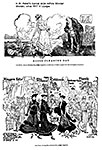
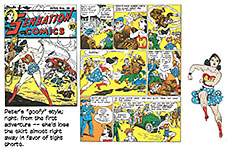
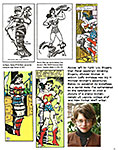

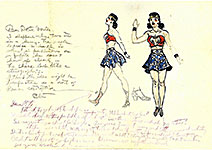



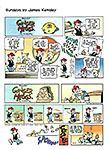

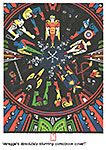
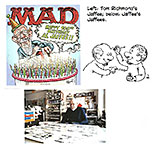
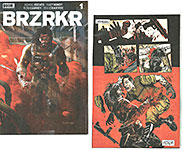



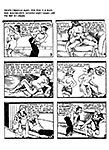

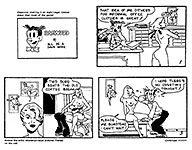


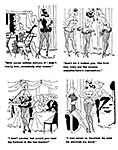
Covers.jpg)
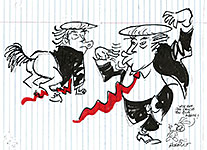
1.jpg)
2.jpg)
3.jpg)
4.jpg)
5.jpg)
6.jpg)
7.jpg)
8.jpg)
9.jpg)


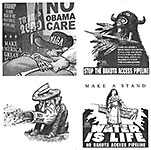
1.jpg)
2.jpg)
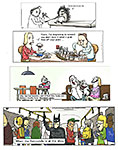
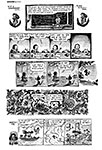
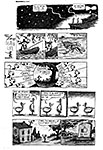

3.jpg)
4.jpg)
5.jpg)
6.jpg)
7.jpg)
